Your Guide to the Modern AI Voice Actor
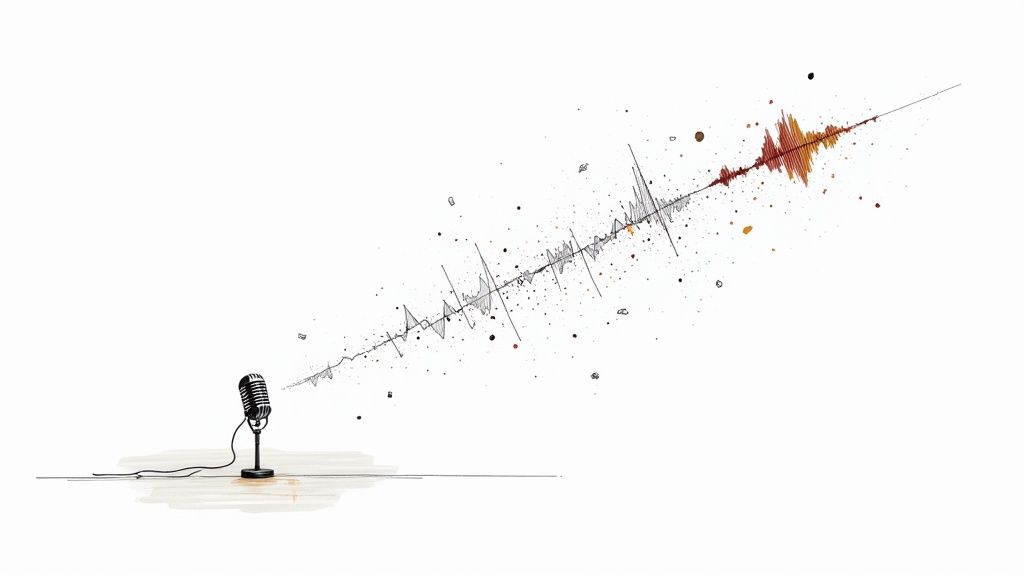
Forget those robotic, monotone voices from your old GPS. An AI voice actor is a whole different beast. Think of it as advanced software that uses artificial intelligence to generate incredibly human-like speech right from a script. It’s essentially a digital performer, one that can read any text with the right emotion, tone, and pacing, making the clunky text-to-speech systems of the past sound ancient.
What Is an AI Voice Actor Anyway?
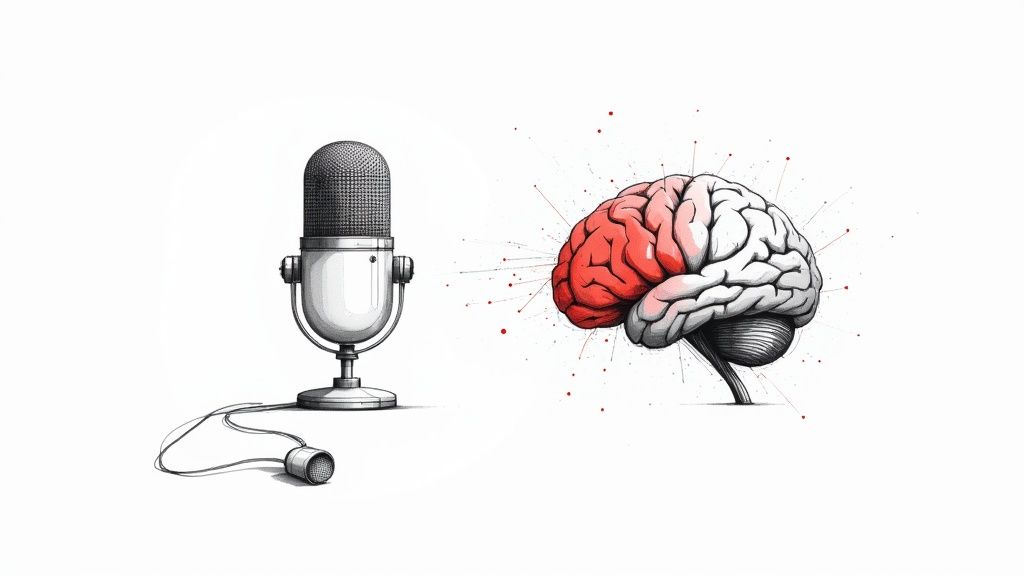
Instead of just a simple text-to-speech reader, picture a digital artist trained on a massive library of human speech. It doesn't just pronounce words; it learns the subtle art of communication. It understands how a voice rises with excitement, softens in a quiet moment, or takes on an authoritative tone. That’s the magic that makes today's AI voices sound so convincingly real.
This technology isn't just for tech giants anymore. It's quickly becoming the go-to solution for content creators, marketers, educators, and businesses of all sizes. Why the sudden rush? It's a fantastic answer to age-old production headaches: high costs, frustratingly slow turnarounds, and the logistical nightmare of hiring and recording human actors.
The Driving Force Behind the Growth
Let's be honest, the demand for high-quality audio content is through the roof, and AI voice actors are perfectly positioned to meet that need. The market numbers tell the story loud and clear. The global AI voice generator market was valued at around USD 4.15 billion in 2024 and is on track to hit an incredible USD 39.35 billion by 2032.
That explosive growth, clocking in at a compound annual growth rate (CAGR) of about 32.47%, is being pushed by our need for personalized content, the boom in voice-activated devices, and huge leaps in AI itself. If you're curious about the nitty-gritty, you can dig into this detailed report about the global AI voice generator market.
This isn't just about making YouTube voiceovers a bit easier. It’s powering a whole range of applications that are becoming a normal part of our lives.
- Personalized Customer Experiences: Brands can finally ditch generic automated greetings and create unique voice interactions.
- Voice-Enabled Assistants: AI gives personality and clarity to our smart speakers and car infotainment systems.
- Accessibility Tools: This is a game-changer for the visually impaired, turning text from websites and documents into clear, easy-to-understand audio.
At its heart, an AI voice actor democratizes professional audio production. It gives anyone with a script the ability to create compelling, studio-quality voiceovers without needing a studio or a huge budget.
Breaking Down the Core Concepts
To really get what an AI voice actor does, it helps to understand a few key ideas. These concepts are the building blocks that work together to turn a simple text file into a rich, engaging audio experience.
To make this a bit easier to digest, here's a quick rundown of the essential components and why they matter.
AI Voice Actor Key Concepts at a Glance
| Concept | Description | Key Benefit |
|---|---|---|
| Text-to-Speech (TTS) | The foundational technology that converts written words into audible speech. | Allows any text, from a short sentence to a full book, to be spoken aloud by the AI. |
| Neural Networks | An AI model inspired by the human brain that learns patterns from massive amounts of data. | Enables the AI to learn the nuances of human speech, like inflection and cadence. |
| Deep Learning | A more advanced form of machine learning using multi-layered neural networks to analyze data. | Allows the AI to generate highly realistic and emotionally expressive vocal performances. |
| Voice Cloning | The process of creating a digital replica of a specific human voice from audio samples. | Offers the ability to create consistent audio using a single, unique brand voice. |
Each of these elements plays a crucial role. From the basic function of TTS to the sophisticated learning of deep neural networks, they all combine to create the natural-sounding, versatile voices we hear today.
The Technology Behind Hyper-Realistic AI Voices
So, what's the secret sauce that makes modern AI voices sound so convincingly human? The jump from the clunky, robotic text-to-speech (TTS) of the past to today's nuanced, emotionally rich audio is a story of incredible technological progress. It all comes down to how the AI learns.
Think of it like training a method actor. Instead of just reading lines from a script, this digital actor is immersed in thousands of hours of real human speech. It doesn't just memorize words; it absorbs the very essence of how we communicate—the subtle rise in pitch for a question, the quickening pace during an exciting story, or the quiet pauses that give weight to a serious moment.
The Power of Neural Networks and Deep Learning
This "training" is all made possible by two key pieces of technology: neural networks and deep learning. A neural network is a type of AI model built to mimic the human brain, allowing it to spot complex patterns in data. Deep learning takes this a step further by using many layers of these networks to analyze information with incredible depth.
Instead of following rigid, pre-programmed rules for pronunciation, these systems learn organically. They listen to massive amounts of human voice data and figure out the unwritten rules of speech all on their own. This allows them to generate unique speech patterns, making sure the final audio sounds dynamic and alive, not repetitive and predictable.
It's this advanced learning that separates a great AI voice from a mediocre one. The system doesn't just "say" words; it performs them, drawing on a deep understanding of how humans actually talk.
The result is a level of realism that was once pure science fiction. This leap in quality hasn't gone unnoticed, either. From both a tech and market perspective, deep learning has allowed AI voice generators to create voices that are almost indistinguishable from our own. In 2023, this market was valued at nearly USD 3.5 billion and is expected to rocket to almost USD 21.75 billion by 2030. This boom is driven by the technology's ability to handle multiple languages, accents, and the tiny nuances of human expression.
From Concatenation to Generation
Older text-to-speech systems used a technique called concatenative synthesis. You can think of this as a digital cut-and-paste job. The system would find pre-recorded snippets of individual words and sounds and then try to stitch them together. The result was often choppy and unnatural because the pieces rarely fit together perfectly.
Today's AI voice actors use generative synthesis, which is a far more sophisticated approach.
- It analyzes the entire script: Instead of looking at one word at a time, the AI takes in the full context of the text to understand its meaning and emotional intent.
- It generates sound waves from scratch: Based on its training, it then creates entirely new audio waveforms, crafting a vocal performance that is coherent and emotionally consistent from start to finish.
- It allows for fine-tuning: This process gives creators incredible control over the final output, letting them adjust pitch, speed, and emotional tone with ease. For a closer look at what makes these voices so believable, check out our guide to realistic text-to-speech voices.
This shift from "stitching" to "creating" is the fundamental reason why today's AI voice performances are so smooth and believable. The technology has evolved from a simple reader to a true digital performer. To really appreciate just how far things have come, resources like Not Another Bot: The Generative AI Show offer a great look into how generative AI is pushing these creative boundaries.
Putting AI Voice Actors to Work in the Real World
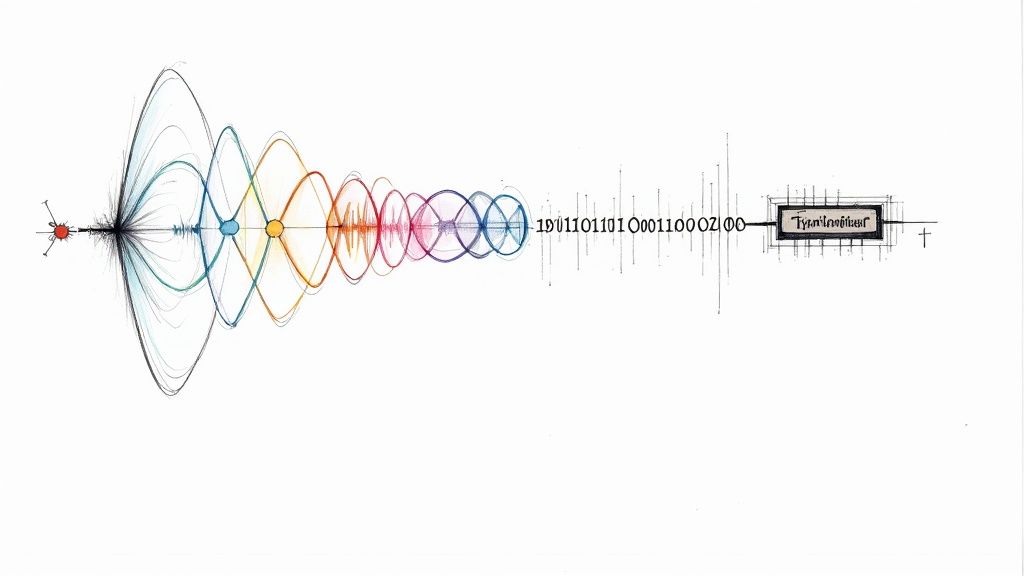
It’s one thing to talk about the tech, but where the rubber really meets the road is seeing how AI voice actors solve everyday problems. These aren’t just a cool gimmick anymore. For creators and businesses juggling tight budgets, impossible deadlines, and the need for consistently good audio, they’re a game-changer.
Whether you're a one-person YouTube channel or a massive corporation, the benefits are surprisingly similar. It all boils down to getting professional-sounding voiceovers without the usual headaches and high costs.
Revolutionizing Content Creation
If you're a content creator on YouTube, TikTok, or Instagram, you know that speed is everything. An AI voice actor lets you knock out polished narration for your videos in a few minutes, not a few days. That means you can jump on trends, publish more often, and keep your brand's voice consistent across every video.
One of the biggest real-world uses we're seeing is the explosion of the AI faceless video generator. These tools pair an AI voice with visuals to create super engaging videos, all without a human ever stepping in front of the camera. It’s a huge win for creators who want to stay anonymous or just don't have the budget for fancy recording equipment.
The numbers back this up. The AI voice generator market was valued at an estimated USD 3.58 billion in 2024. That figure is expected to skyrocket to USD 36.43 billion by 2032, mostly because of how deeply it's being integrated into digital media. It shows just how vital these tools have become.
Powering Education and Training
In the e-learning and corporate training space, keeping people engaged is the name of the game. AI voice actors are completely changing how educational content gets made.
- Engaging E-Learning Modules: Instead of a single, monotone voice, instructional designers can now use different character voices to make courses feel more like a dynamic conversation.
- Rapid Updates: Course content out of date? No problem. You don't have to track down and re-hire a voice actor. Just tweak the script, regenerate the audio, and your materials are instantly current.
- Global Accessibility: With voices available in tons of languages and accents, companies can finally localize training programs for their global teams without breaking a sweat.
The ability to generate consistent, high-quality audio at scale makes an AI voice actor a secret weapon for any organization serious about education.
Expanding into New Frontiers
But it doesn't stop with online videos and training modules. Industries are getting creative and finding all sorts of new ways to use this tech.
- Video Game Development: Indie game devs can now afford to fill their worlds with unique voices for non-player characters (NPCs) and quickly prototype dialogue. It makes games feel so much richer and more alive.
- Podcast and Audiobook Production: Podcasters can use an AI voice as a co-host or narrator. It’s also a fantastic way to turn blog posts and articles into audio, opening up a whole new audience.
- Accessibility Services: This is a big one. AI voices are the engine behind screen readers that turn text into clear audio, making the web a more accessible place for people with visual impairments.
- Customer Service Solutions: Businesses are swapping out those old, robotic phone menus for more natural-sounding Interactive Voice Response (IVR) systems, making for a much less frustrating customer experience.
Picking the right tool is the final piece of the puzzle. Some platforms offer a massive voice library, while others are all about being user-friendly. If you're just starting out, checking out some free voice over software options is a great way to figure out what you really need for your projects.
How to Choose the Right AI Voice Actor Tool
With so many AI voice actor tools popping up, picking the right one can feel like a chore. The secret is to look past the slick marketing and zero in on the features that will actually help your project succeed. A little bit of homework now will save you a ton of headaches later.
The first thing you should always do is listen. Seriously, just listen to the audio samples. Do the voices sound natural and believable? Or can you still hear that faint, tell-tale robotic buzz? A great AI voice should be able to deliver complex sentences and handle emotional shifts without sounding disjointed.
Beyond that, think about variety. A deep library of voices gives you options. You might need a friendly, energetic voice for a TikTok ad today and a deep, serious tone for a corporate training video tomorrow. The more choices you have, the better.
Core Features to Evaluate
When you start comparing different platforms, it helps to know what to look for. Not every tool is built the same, so what works for a podcaster might be a terrible fit for a game developer.
Here are the big things to keep an eye on:
- Voice Quality and Naturalness: This is the absolute deal-breaker. If the voices don't sound human, they won't connect with your audience.
- Voice Library and Variety: Look for a good mix of ages, genders, accents, and languages. You want the freedom to find the perfect voice for any character or script.
- Customization Controls: Can you tweak the delivery? The best tools let you adjust the speed, pitch, add pauses, and even inject emotion to get the performance just right.
- Ease of Use: A clunky, confusing interface is a creativity killer. A straightforward platform, like Lazybird.app, lets you generate your audio fast, without needing to read a manual.
Finding the right tool isn't about getting the one with the most features; it's about getting the one with the right features for you. Simplicity and effectiveness often trump a long list of complex, unnecessary options.
This image gives you a quick visual breakdown of how different AI voice platforms stack up on key metrics.
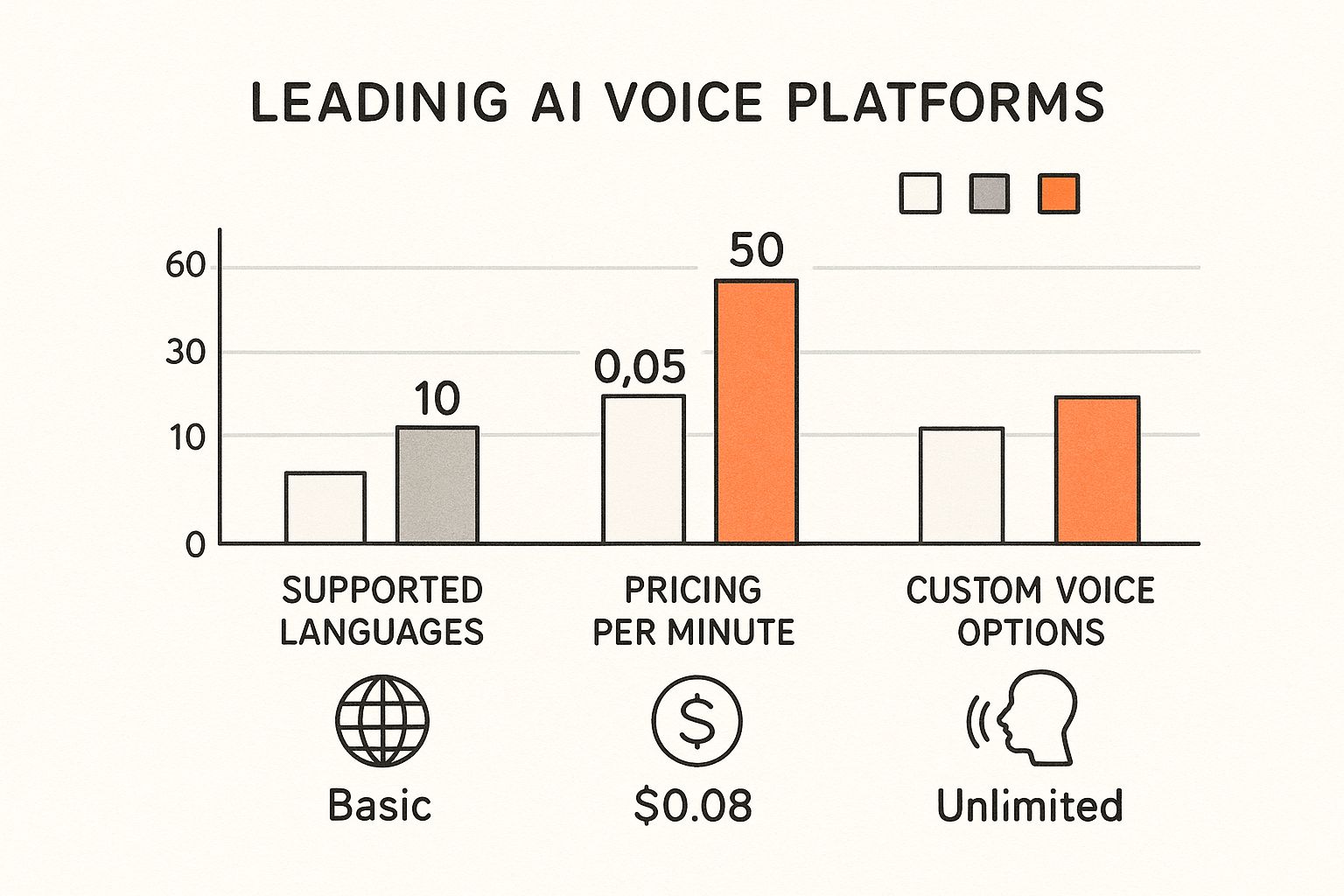
As you can see, there's a huge difference in things like language support and cost, which really drives home the point of matching a tool to your specific project needs and budget.
Comparing Top AI Voice Actor Platforms
To help you cut through the noise, here's a quick comparison of some of the top platforms out there. Each has its own strengths, so think about what's most important for your work.
| Platform | Best For | Key Features | Pricing Model |
|---|---|---|---|
| Lazybird.app | Simplicity and one-off projects. Great for creators who need high-quality audio without a subscription. | Extremely easy-to-use interface, diverse voice library, no long-term commitment. | Pay-as-you-go |
| Murf.AI | Collaborative team projects and video creation. | Voice cloning, team workspaces, video editing tools, large library of stock media. | Subscription-based |
| ElevenLabs | High-fidelity voice cloning and realistic speech. | Industry-leading voice cloning, emotional range, API access for developers. | Freemium & Subscription |
| Play.ht | Podcasters and content creators with high-volume needs. | SEO-friendly audio articles, podcasting tools, WordPress plugin. | Subscription-based |
This table should give you a solid starting point. For many users, a tool like Lazybird.app hits the sweet spot—it’s powerful enough to produce professional results but simple enough that you can get started in minutes.
Comparing Pricing Models
AI voice actor pricing is all over the map, so it’s important to figure out how you'll be charged. Some models are better for heavy, consistent use, while others are perfect for occasional projects.
- Subscription Plans: These are very common. You typically pay a monthly fee for a set number of characters or hours of audio generation. This is a good fit if you have predictable, ongoing needs.
- Pay-As-You-Go: This model lets you pay only for what you actually use, usually by the character or minute. It's a fantastic option for one-off projects or if your workflow is inconsistent. Lazybird.app, for example, uses a simple pay-per-character model with no subscription, which offers incredible flexibility.
- Freemium Tiers: Many tools will give you a free plan with some limitations, like a small character allowance. This is the best way to test drive a platform's quality and interface before you spend any money.
In the end, the best choice really boils down to your personal workflow. Find a tool that delivers great-sounding voices, is easy to control, and has a price tag that makes sense for how you work. That’s the key to creating amazing audio content without breaking the bank.
Create Your First Voiceover with Lazybird in Minutes
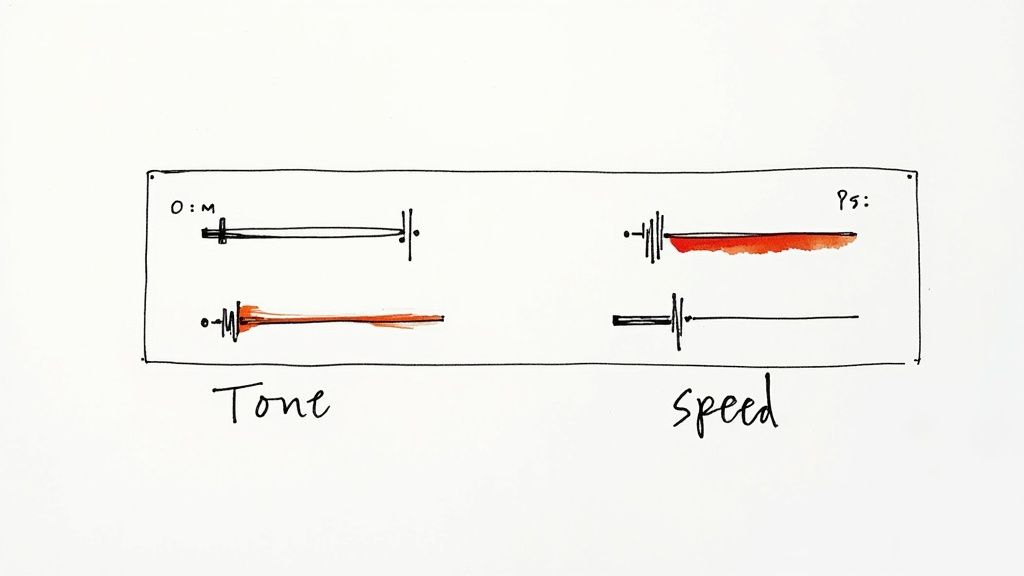
Talking about the theory is one thing, but the best way to really get the power of a modern AI voice actor is to just dive in and try it. Creating your first voiceover shouldn't feel like a chore. With the right tool, you can turn a plain text script into a polished audio track in less time than it takes to brew a pot of coffee.
This is exactly why we built Lazybird. We’ve stripped away all the complex technical hurdles so you can just focus on your message and creativity. Let's walk through just how quickly you can get a professional-sounding voiceover.
Step 1: Paste Your Script
First things first. When you open the Lazybird editor, you'll see a clean text box ready for your script. This is where the magic starts.
Simply type directly into the editor or, more likely, copy and paste your text from a Word doc or Google Doc. It doesn't matter if it's a single line for a social media ad or a full script for an explainer video—just get your words in the box.
Step 2: Choose Your Voice
Now for the fun part: casting your AI voice actor. Lazybird has a growing library of over 200 distinct character voices available in more than 100 languages and accents. This is crucial for finding a voice that perfectly matches your brand's personality.
Take a minute to browse the library and listen to the samples. You can filter by gender, age, or style to find what you need fast. Need a warm, inviting voice for a tutorial? Done. How about a deep, commanding tone for a documentary? You'll find plenty of options.
Think of this step like casting a real actor. The voice you choose sets the entire mood of your content. Take a moment to find one that not only sounds good but also connects with the message you want to send.
Step 3: Fine-Tune the Performance
You've got a script and a voice. Now it's time to direct the performance. This is how you take a good voiceover and make it truly great. Lazybird gives you simple controls to adjust the delivery until it's just right.
- Pacing and Speed: Slow the voice down for a more thoughtful, deliberate delivery. Or speed it up for a high-energy, punchy feel.
- Pitch Control: A slight adjustment to the pitch can help the voice sound more unique or add a subtle layer of emotion.
- Adding Pauses: This is a surprisingly powerful tool. You can insert strategic pauses to add emphasis, build suspense, or just give your audience a moment to digest a key point. It’s a simple trick that makes the final audio sound much more natural.
Once you’ve made your tweaks, hit "Generate." In just a few seconds, you can listen to the result. If it's not quite perfect, just go back and adjust the settings until it is. For a more detailed guide focused on video content, check out our article on how to create an AI voice over for videos in minutes.
Step 4: Download Your Audio
Happy with the final take? The last step is to simply download your audio. Lazybird gives you a high-quality audio file that’s ready to be dropped straight into your video editor, e-learning course, or podcast software.
And that's really all there is to it. In just four steps, you’ve created a professional-grade voiceover without needing a single piece of expensive recording gear or any technical know-how. The whole process is built to be fast, simple, and accessible to anyone.
The Future of AI Voice and Creative Expression
The journey of the AI voice actor is just getting started. If you think the technology is impressive now, just wait. We're on the cusp of a future where these digital voices are woven deeply into our creative process, capable of things that sound like pure sci-fi.
Think about an AI that can do more than just read lines—one that can actually improvise. Imagine a voice tool that can switch styles or emotions on the fly, taking direction just like a human actor. This is where we're headed. The next step isn't just a better performer; it's a genuine creative partner.
Navigating the Ethical Landscape
As this technology gets more powerful, so does the need to talk about using it responsibly. The ability to spin up a realistic voice out of thin air is incredible, but it also carries serious weight. We can't just brush aside the potential for misuse, like creating convincing deepfakes or cloning someone's voice without permission.
We've already seen this happen. Content creators have woken up to find their voices stolen and used in ads they never approved. These incidents shine a bright light on a major problem: while there are rules for using a person's image, the laws around AI voice cloning are still playing catch-up. There isn't a federal right of publicity in the U.S., which means protection is a messy patchwork of state laws.
This technology must be developed with a strong ethical compass. The goal should be to empower creativity, not to enable deception or infringe upon the rights of individuals. It's a balance of innovation and integrity.
Another huge piece of the puzzle is making sure the human artists who train these AI models are paid fairly. As the tech matures, we absolutely need clear rules and fair practices. This will ensure that human talent is respected and valued, not just treated like a data mine.
An Instrument for Amplified Creativity
It's easy to look at the AI voice actor and see it as a replacement for human talent. But that's a pretty narrow view. A better way to think about it is as a revolutionary new instrument, much like the synthesizer was for music. It didn't replace musicians; it gave them a wild new tool to create sounds no one had ever heard before.
Looking ahead, we're even seeing AI voice being paired with visual elements. The work being done exploring AI avatars and emotional connection in videos shows just how much creative territory is opening up.
The future is all about collaboration. An AI voice actor can handle the more routine work—like generating placeholder audio, creating hundreds of character variations for video games, or localizing content into dozens of languages. This frees up human actors to pour their energy into the complex, high-impact performances that truly need a human soul. For creators, this means way more freedom to experiment and bring their wildest ideas to life, completely reshaping the audio world for years to come.
Frequently Asked Questions About AI Voice Actors
As AI voices become more common in everything from YouTube videos to video games, it's natural to have questions. If you're a creator wondering how this all works, you're not alone. Let's tackle some of the biggest questions people have about the modern AI voice actor.
Is It Legal to Use AI Voices?
Yes, using an AI voice actor is perfectly legal—as long as you stick with a reputable service like Lazybird. Platforms like this have done the hard work of securing the rights to the voice data that powers their AI models.
Where things get murky is with unauthorized voice cloning. We've all seen headlines about creators finding their voices used in ads without their consent. This is a huge ethical and legal gray area.
The real problem is that the law hasn't caught up with the tech. While there are rules about using someone's image, there's no single federal law in the U.S. covering voice rights. This leaves a messy patchwork of state laws that don't always offer clear protection against AI voice cloning.
Will AI Voice Actors Replace Human Actors?
This is the million-dollar question, isn't it? The short answer is no. It’s far more likely we'll see collaboration, not a total replacement.
Think of an AI voice actor as another tool in the creative toolbox. It’s fantastic for tasks that demand speed and scale. Need to voice hundreds of background characters for a game? Or translate a training module into 20 languages? AI is your best friend.
This actually frees up human actors to focus on what they do best: delivering emotionally rich, nuanced performances for lead roles where that human soul is irreplaceable. The AI handles the grunt work, while the human actor provides the heart.
How Much Does an AI Voice Actor Cost?
The price tag can swing wildly from one service to another. Many platforms push a monthly subscription, which can be great if you're constantly churning out content. But for most creators, a pay-as-you-go option just makes more sense.
With a tool like Lazybird, you skip the subscription trap entirely. You only pay for the characters you actually generate. It’s a super cost-effective way to get professional-grade audio for one-off projects or even for ongoing needs without being locked into a fixed monthly bill.
Ready to hear the difference for yourself? With Lazybird, you can turn your script into a polished, professional voiceover in just minutes. Explore over 200 voices in 100+ languages and discover how easy it is to create high-quality audio with no subscriptions and no hassle. Get started with Lazybird today.